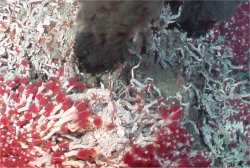
December Editorial

December Editorial
Life in Deep Ancient Rocks |
|
Everyone knows of the potential for extraterrestrial life, but what about the existence of 'intraterrestial' life? The discovery of life deep below the Earth has just been confirmed by a research team which has found the evidence in ancient mantle rock below the sea floor. More particularly, this was rock pulled to the sea floor in the Early Cretaceous period - around 125 million years ago. A study of samples found that this rock contained the fossilized remains of microbes which had developed far below the Earth's surface. |
|
|
The evidence was published in September 2015 in the journal Proceedings of the National Academy of Sciences, and the discovery was the result of the efforts of a three-way research team consisting of scientists from Virginia Tech, the University of Bremen and the Woods Hole Oceanographic Institution (WHOI – which is generally considered as the world's leading non-profit private oceanographic research organization.) There has long been a theory that conditions for life can result from the interaction between seawater and rocks deep in the mantle, but the scientists who proved that life could indeed develop here were not originally looking to prove this hypothesis. 'We were initially looking at how seawater interacts with mantle rocks, and how that process generates hydrogen,' said Frieder Klein, lead author of the paper. However, while analysing drill samples, the scientists discovered organic inclusions that could only have been created by living organisms. These rock samples were extracted from the Atlantic Ocean off the coast of Iberia in 1993. It was only two decades later that the team looked at these samples for their research. Consequently, extra effort had to be made to ensure that what was being studied was the material from the deep Earth and not the result of later contamination. For their research the team used high-resolution microscopy, a specialized spectrometer and isotopic analysis. The spectrometry revealed the presence of lipids in the rock, and the appearance of fatty acids in this environment strongly suggested the existence of living creatures. The scientists concluded that the life had developed at about the time that the super-continent Pangaea began to break apart. A large rift developed in the continent, a rift which was eventually to become the Atlantic Ocean. This developing rift pulled rocks up from the deep mantle towards the sea floor, and seawater infiltrating cracks in this rock reacted with the chemicals within to create a hydrothermal fluid. (Hydrothermal fluid is hot liquid within the Earth which contains minerals in solution.) Although this fluid was at high temperature and very alkaline, it nevertheless contained hydrogen, methane and dissolved carbon – the basic ingredients needed to sustain life. Dr Klein explains, 'Colonies of bacteria and archaea [a specialized micro-organism that grows near hot vents] were feeding off the seawater-hydrothermal fluid mix and became engulfed in the minerals growing in the fractured rock. This kept them completely isolated from the environment. The minerals proved to be the ultimate storage containers for these organisms, preserving their lipids and proteins for over 100 million years.' The team have noted similarities between the micro-organisms which they have discovered and the life forms clustered around the vents of the Lost City Hydrothermal Field in the mid-Atlantic Ocean. In the 'Lost City' reactions between seawater and upper mantle peridotite produce highly alkaline fluids rich in methane and hydrogen. The field has chimney-like vents made of calcium carbonate and - as well as many smaller vents - some 30 chimneys are 30 to 60 meters tall. It has been theorized that ancient versions of the Lost City vents could have created the conditions for the origin of life on Earth, so the discovery of life in ancient mantle rocks is an exciting step towards validating this hypothesis. Referece: | |
| _______________________________ | ||||
| Home | | | Shopping | | | Database |
© Biscuit Software 2004-2015
All rights reserved